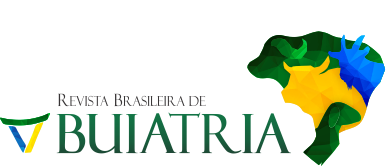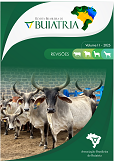uma nova perspectiva de tratamento em ruminantes
A terapia fotodinâmica antimicrobiana (TFDa) tem demonstrado grande potencial na inativação de vários microrganismos
clinicamente importantes em diversas áreas da saúde, incluindo a Medicina Veterinária. O mecanismo de ação dessa
modalidade terapêutica está associado ao desenvolvimento de reações fotofísicas e fotoquímicas que culminam com a
inviabilização de células ou patógenos no tecido alvo através de espécies reativas de oxigênio (ERO). As ERO são geradas
pela interação entre um comprimento de onda emitido por um dispositivo de laser e LED (Light-Emitting Diode),
um fotossensibilizador (FS) e o oxigênio molecular. Na buiatria, diversas enfermidades de importância clínica, econômica
e epidemiológica vêm sendo submetidas a TFDa com resultados satisfatórios, o que evidencia a possibilidade da
utilização prática desta técnica de forma individual ou em associação com outras modalidades terapêuticas. Enfermidades
podais, mastites, linfadenite caseosa, otites e feridas cirúrgicas em bovinos, ovinos e caprinos são alguns dos exemplos
de alterações com resultados eficientes quando tratada pela TFDa. Além dos efeitos clínicos diretos ocasionados pela
TFDa, sua utilização pode auxiliar no combate à resistência microbiana, que é um problema de grande relevância para a
saúde animal e humana, à medida que pode reduzir o uso de fármacos em diversas situações. Para que a TFDa seja amplamente
utilizada na Medicina Veterinária e promova efeitos cada vez mais satisfatórios, seguros e replicáveis é extremamente
necessário a realização de novos estudos que determinem parâmetros dosimétricos para luz e para as concentrações
do FS, demonstrando a eficácia da terapia e suas possíveis aplicações na buiatria.
Palavras-chave: laser, LED, luz, fotossensibilizador, espécies reativas de oxigênio.
Antimicrobial photodynamic therapy (aPDT) has shown great potential in the inactivation of several clinically important
microorganisms in different areas of health, including Veterinary Medicine. e mechanism of action of this
therapeutic modality is associated with the development of photophysical and photochemical reactions that result in the
inactivation of cells or pathogens in the target tissue through reactive oxygen species (ROS). ROS are generated by the
interaction between a wavelength emitted by a laser or LED (Light-Emitting Diode) device, a photosensitizer (PS), and
molecular oxygen. In buiatrics, several diseases of clinical, economic, and epidemiological importance have been subjected
to aPDT with satisfactory outcomes, which highlights the practical applicability of this technique either as a
stand-alone approach or in association with other therapeutic modalities. Foot diseases, mastitis, caseous lymphadenitis,
otitis, and surgical wounds in cattle, sheep, and goats are some examples of conditions effectively treated with aPDT.
Beyond the direct clinical effects of aPDT, its use may help to combat antimicrobial resistance, a highly relevant issue for
both animal and human health, as it can reduce the use of drugs in various situations. For aPDT to be widely adopted in
Veterinary Medicine and promote increasingly satisfactory, safe, and reproducible outcomes, further studies are essential
to determine dosimetric parameters for light and photosensitizer concentrations, demonstrating the efficacy of the
therapy and its potential applications in buiatrics.
Keywords: laser, LED, light, photosensitizer, reactive oxygen species.
1. BACELLAR, I.O. et al. Photodynamic efficiency: from molecular photochemistry to cell death. International Journal of Molecular Sciences, v.16, n.9, p.20523-20559, 2015.
2. VELAZQUEZ-MEZA, M.E. et al. Antimicrobial resistance: one health approach. Veterinary World, v.15, n.3, p.743-749, 2022.
3. WU, X.; HU, Y. Photodynamic therapy for the treatment of fungal infections. Infection and Drug Resistance, v.15, p.3251-3266, 2022.
4. AKHATAR, F. et al. A. Antimicrobial and antibiofilm photodynamic therapy against vancomycin resistant Staphylococcus aureus (VRSA) induced infection in vitro and in vivo. European Journal of Pharmaceutics and Biopharmaceutics. v.160, p.65-76, 2021.
5. BAGNATO, V.S.; REQUENA, M.B. Terapia Fotodinâmica Dermatológica: Programa TFD Brasil. 1ªed. São Carlos: Compacta Gráfica e Editora, 2015. 312 p.
6. DOVIGO, L.N. et al. Curcumin-mediated photodynamic inactivation of Candida albicans in a murine model of oral candidiasis. Medical Mycology, v.51, n. 3, p.243-251, 2013.
7. KATTAN, H.F. Efficacy of antimicrobial photodynamic therapy (PDTa) in reducing cariogenic bacteria in primary deciduous dentine. Photodiagnosis and Photodynamic Therapy, v.36, 102600, 2021.
8. SILVA, W.R. et al. Photodynamic therapy in the coadjuvant treatment of Sporothrix schenckii complex. Special Care in Dentistry, v.44, n.2, p.486-490, 2024.
9. OKAMOTO, C.B. et al. Photodynamic therapy for endodontic treatment of primary teeth: a randomized controlled clinical trial. Photodiagnosis and Photodynamic Therapy, v.30, 101732, 2020.
10. PERUSSI, J.R. Inativação fotodinâmica de microrganismos. Química Nova, v.30, n.4, p.999-994, 2007.
11. JORI, G. et al. Photodynamic therapy in the treatment of microbial infections: basic principles and perspective applications. Lasers in Surgery and Medicine, v.38, n.5, p.468-481, 2006.
12. PELOI, L.S. et al. Photodynamic therapy for American cutaneous leishmaniasis: The efficacy of methylene blue in hamsters experimentally infected with Leishmania (Leishmania) amazonensis. Experimental Parasitology, v.128, n.4, p.353-356, 2011.
13. HABERMEYER, B.; GUILAR, R. Some activities of PorphyChem illustrated by the applications of porphyrinoids in PDT, PIT and PDI. Photochemical & Photobiological Sciences, v.17, n.11, p.1675-1690, 2018.
14. ROLA, P. et al. The use of low-level energy laser radiation in basic and clinical research. Advances in Clinical and Experimental Medicine, v.23, n.5, p. 835-842, 2014.
15. SOBOTTA, L. et al. Porphyrinoid photosensitizers mediated photodynamic inactivation against bacteria. European Journal of Medicinal Chemistry, v.175, p.72-106, 2019.
16. SABINO, C.P. et al. The Biochemical mechanisms of antimicrobial photodynamic therapy. Photodiagnosis and Photodynamic Therapy, v.99, n.2, p.742-750, 2022.
17. YOON, I. et al. Advance in photosensitizers and light delivery for photodynamic therapy. Clinical Endoscopy, v.46, n.1, p.7-23, 2013.
18. GILABERTE, Y. et al. Cutaneous sporotrichosis treated with photodynamic therapy: an in vitro and in vivo study. Photomedicine and Laser Surgery, v.32, n.1, p.54-57, 2014.
19. YANG, F. et al. Spotlight on porphyrins: classifications, mechanisms and medical applications. Biomedicine & Pharmacotherapy, v.164, 114933, 2023.
20. SELLERA, F.P. et al. Clinical applications of antimicrobial PDT. In: SELLERA, F.P. et al. Photodynamic Therapy in Veterinary Medicine: From Basics to Clinical Practice. Switzerland: Springe, 2016. v.2, p.228.-230.
21. SELLERA, F.P. et al. Methylene blue-mediated antimicrobial photodynamic therapy can be a novel non-antibiotic platform for bovine digital dermatitis. Photodiagnosis and Photodynamic Therapy, v.34, 102274, 2021.
22. SILVA, L.O. et al. Use of photodynamic therapy and photobiomodulation as alternatives for microbial control on clinical and subclinical mastitis in sheep. Lasers in Medical Science, v.37, n.4, p.2305-2310, 2022.
23. BERRA, C.M, et al. Estresse oxidativo, lesões no genoma e processos de sinalização no controle do ciclo celular. Química Nova, v.29, n.6, p.1340-1344, 2006.
24. BARBOSA, A.F.S. et al. Anti-Trypanosoma cruzi effect of the photodynamic antiparasitic chemotherapy using phenothiazine derivatives as photosensitizers. Lasers in Medical Science, v.35, n.1, p.79-85, 2020.
25. RODHE, M. The gram-positive bacterial cell wall. Microbiology Spectrum, v.7, n.3, 10.1128, 2019.
26. LA SELVA, A. et al. Treatment of herpes labialis by photodynamic therapy: study protocol clinical trial (SPIRIT compliant). Medicine. v.99, n.12, e19500, 2020.
27. LOZANO, C.; TORRES, C. Actualización en la resistencia antibiótica en gram positivos. Enfermedades Infecciosas y Microbiología Clínica, v.35, Supl.1, p.2-8, 2017.
28. SABINO, C.P. et al. Photodynamic Therapy in Veterinary Medicine: From Basics to Clinical Practice. Suiça: Springer, 2016. p.228-234.
29. NUNEZ, S.C. et al. Terapia Fotodinâmica Antimicrobiana na Odontologia. 2ªed. Rio de Janeiro: Elsevier, 2019. p.258-300.
30. RKEIN, A.M.; OZOG, D.M. Photodynamic therapy. Dermatologic Clinics, v.32, n.3, p.415-425, 2014.
31. HOU, Y.J. et al. Pathological mechanism of photodynamic therapy and photothermal therapy based on nanoparticles. International Journal of Nanomedicine, v.15, p.6827-6838, 2020.
32. GUO, Y. et al. Photodynamic therapy treats acne by altering the composition of the skin microbiota. Skin Research and Technology, v.29, n.1, e13269, 2023.
33. CUNHA, B.R. et al. Antibiotic discovery: where have we come from, where do we go? Antibiotics. v.8, n.2, p.1-21, 2019.
34. KWIATKOWSKI, S. et al. Photodynamic therapy - mechanisms, photosensitizers and combinations. Biomedicine & Pharmacotherapy, v.106, p.1098-1107, 2018.
35. HAMBLIN, M.R.; HASAN, T. Photodynamic therapy: a new antimicrobial approach to infectious disease? Photochemistry and Photobiology, v.3, n.5, p.436-450, 2004.
36. FISHER, J.F.; MOBASHARY, S. Constructing and deconstructing the bacterial cell wall. Protein Science, v.29, n.3, p.629-646, 2020.
37. SHARMA, B. et al. Efficient photodynamic therapy against gram-positive and gram-negative bacteria using rose bengal encapsulated in metallocatanionic vesicles in the presence of visible light. ACS Applied Bio Materials, v.3, n.12, p.8515-8524, 2020.
38. MAROTTI, J. et al. Photodynamic therapy can be effective as a treatment for herpes simplex labialis. Photomedicine and Laser Surgery, v.27, n.2, p.357-363, 2009.
39. LI, W. Nanotechology-based strategies to enhance the efficacy of photodynamic therapy for cancers. Entrepreneurship and Innovation During Austerity, v.10, n.8, p.851-860, 2009.
40. RAJESH, S. et al. Antimicrobial photodynamic therapy: an overview. Journal of Indian Society of Periodontology, v.15, n.4, p.323-327, 2018.
41. DENG, K. et al. Recent progress in near infrared light triggered photodynamic therapy. Nano Micro Small, v.13, n.44, p.1-27, 2017.
42. MOREIRA, L.H. et al. Use of photodynamic therapy in the treatment of bovine subclinical mastitis. Photodiagnosis and Photodynamic Therapy, v.21, p.246-251, 2018.
43. CALIN, M.A.; PARASCA, S.V. Light sources for photodynamic inactivation of bacteria. Lasers in Medical Science, v.24, n.3, p.453-460, 2009.
44. CALZAVARA-PINTON, P.G. et al. A comprehensive overview of photodynamic therapy in the treatment of superficial fungal infections of the skin. Journal of Photochemistry and Photobiology B: Biology, v.78, n.1, p.1-6, 2005.
45. BRUNDAGE, C.; BURMAYAN, A. Caseous lymphadenitis outbreak in a small ruminant herd. Open Veterinary Journal, v.11, n.4, p.530-534, 2021.
46. RONSEIN, G.E. et al. Oxidação de proteínas por oxigênio singlete: mecanismos de dano, estratégias para detecção e implicações biológicas. Química Nova, v.29, n.3, p.563-568, 2006.
47. SPERANDIO, F.F. et al. Antimicrobial photodynamic therapy to kill gram-negative bacteria. Recent Patents on Anti-Infective Drug Discovery, v.8, n.2, p.108-120, 2013.
48. SELLERA, F.P. et al. Antimicrobial photodynamic therapy for caseous lymphadenitis abscesses in sheep: Report of ten cases. Photodiagnosis and Photodynamic Therapy, v.13, p.120-122, 2016.
49. SENGE, M.O. et al. Classic highlights in porphyrin and porphyrinoid total synthesis and biosynthesis. Chemical Society Reviews, v.50, n.7, p.4730-4789, 2021.
50. MOYES, R.B. et al. Differential staining of bacteria: gram stain. Current Protocols in Microbiology, v.15, p.1-8, 2009.
51. SELLERA, F.P. et al. Effective treatment and decolonization of a dog infected with carbapenemase (VIM-2)-producing Pseudomonas aeruginosa using probiotic and photodynamic therapies. Veterinary Dermatology, v.3, 10.1111, 2018.
52. SILVA, M.V.A. et al. Laser photobiomodulation and antimicrobial photodynamic therapy in the treatment of ovine otitis. Acta Scientiae Veterinariae, v.49, Supl.1, 640, 2021.
53. ALZAMORA FILHO, F. et al. Utilização da terapia fotodinâmica antimicrobiana e fototerapia a laser no tratamento da dermatite interdigital infecciosa ovina. Revista Acadêmica Ciência Animal, v.16, Ed. Esp. 3, p.1-5, 2018.
54. FRANCO, J.P. et al. Evidências do efeito da terapia fotodinâmica sobre infecções podais em vacas leiteiras no município de Fernandópolis, São Paulo, Brasil. Revista Brasileira de Medicina Veterinária, v.38, n.3, p.257-264, 2016.
55. SEEGER, M.G. et al. Antimicrobial efficacy of in vitro and ex vivo photodynamic therapy using porphyrins against Moraxella spp. isolated from bovine keratoconjunctivitis. World Journal of Microbiology and Biotechnology, v.38, n.6, 103, 2022.
56. GARCIA, M.T. et al. Photodynamic therapy mediated by chlorin-type photosensitizers against Streptococcus mutans biofilms. Photodiagnosis and Photodynamic Therapy, v.24, p.256-261, 2018.
57. BABINSKI, T.P. et al. Uso da curcumina na terapia fotodinâmica antimicrobiana: uma revisão. Brazilian Journal of Health Review, v.5, n.2, p.7259-7271, 2022.
58. NUNES, L.P. et al. Antimicrobial photodynamic therapy in endodontic reintervention: a systematic review and meta-analysis. Photodiagnosis and Photodynamic Therapy. v.39, 103014, 2022.
59. FISCHETTI VA. Surface proteins on gram-positive bacteria. Microbiology Spectrum, v.7, n.4, 10.1128, 2019.
60. FERNANDES, K.P.S. et al. Biofotônica Conceitos e Aplicações. 1ªed. São Paulo: Universidade Nove de Julho, 2017. p.71-92.
61. KOLARIKOVA, M. et al. Photodynamic therapy: innovative approaches for antibacterial and anticancer treatments. Medicinal Research Reviews, v.43, n.4, p.717-774, 2023.
62. HALLIWELL, B.; CHIRICO, S. Lipid peroxidation: its mechanism, measurement, and significance. The American Journal of Clinical Nutrition, v.57, Supl.5, p.715-724, 1993.
63. CONRADO, P.C.V. et al. A systematic review of photodynamic therapy as an antiviral treatment: Potential guidance for dealing with SARS-CoV-2. Photodiagnosis and Photodynamic Therapy, v.34, 102221, 2021.


